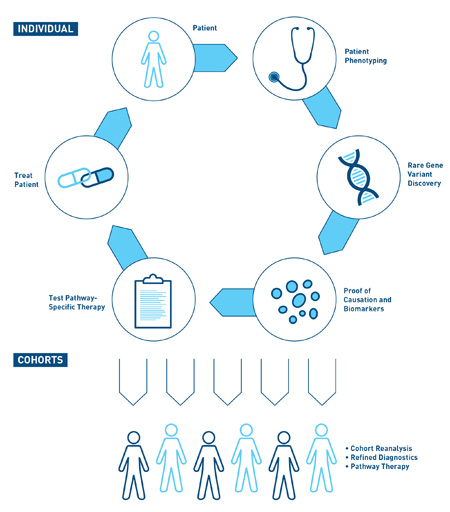How does it work?

Patient
1. Patients provide written informed consent to participate before being included in a China-Australia CPI patient cohort. To find out if you qualify please contact us in the region most relevant for you.
Patient Phenotyping
2. A medical examination is taken, including your medical history and signs and symptoms.
3. We will take blood samples from you to analyse biological markers on the surface of the immune cells in the blood to further characterise your phenotype*.
* phenotype: the observable properties of an organism that are produced by the interaction of the genotype and the environment (Merriam-Webster Dictionary, 2015).
Rare Gene Variant Discovery
4. Your DNA is extracted from the blood samples and your entire genetic code (genome) is sequenced using whole genome sequencing (WGS).
5. In conjunction with our bioinformatics team the CPI clinical researcher can identify from thousands of genetic variations in the genome those that could contribute to causing your disease or be affecting the normal course of treatment. These genetic variants are known as single nucleotide polymorphisms or SNPs (pronounced 'snips'). Sometimes the gene identified will be well described or in a biological pathway that is well-known, but the impact from the particular gene variant may not be well understood.
Proof of Causation and Biomarkers
6. Once potential disease-causing gene(s) are identified they are transferred into human cell lines and/or mouse models. This enables our researchers to confirm the function of the mutated gene(s) and to identify which genetic variants are instrumental in causing diisease. It will also help to establish novel models of human immune disease.
7. Identification of these gene variant(s) has the potential to lead to the discovery of new biomarkers and improving diagnoses.
Test Pathway-Specific Therapy
8. The identification of genetic variant(s) that are causing your disease will enable the CPI team to help provide more effective treatment. The potential treatments will be tested in the laboratory to ascertain how effective they are. These could be drugs that are already available or direct research into new therapeautic targets.
Treat Patient
9. Improved 'personalised' therapeutic options for you that are more effective with reduced side effects.
We, at the China-Australia CPI, cannot know in advance how quickly research findings will translate into improved treatments but we do know it will get faster with more resources to build the process across diseases.
